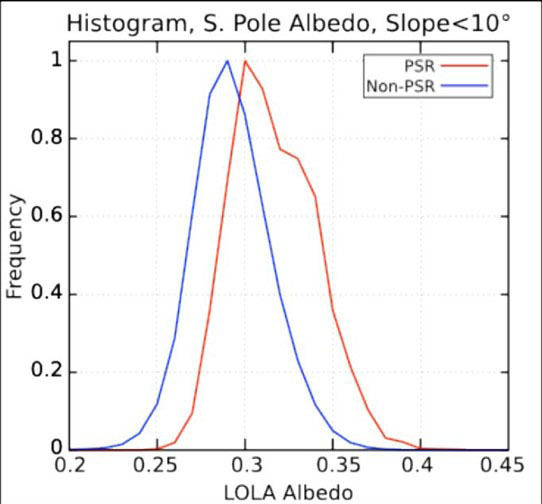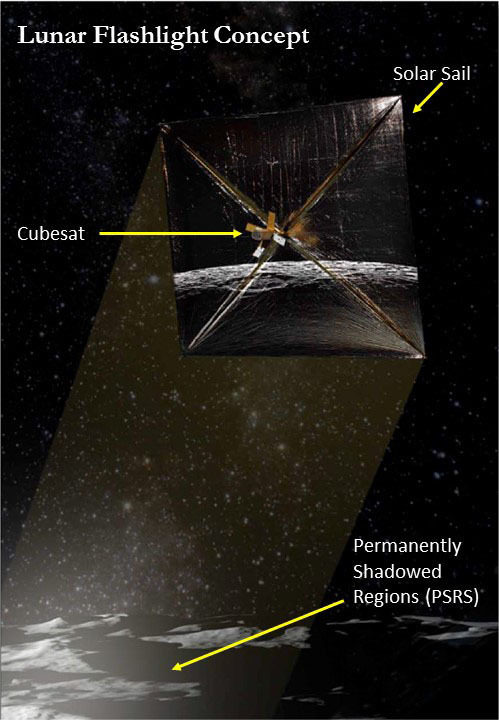Deepak Dhingra • Nov 21, 2014
Lunar Polar Volatile Puzzle
I have loads of excitement to share from the recent Lunar Exploration and Analysis Group (LEAG) meeting at Johns Hopkins University Applied Physics Lab (JHU-APL) in Baltimore. The wealth of data from recent and current lunar missions is enabling the development of new approaches for refining our understanding of the occurrence and distribution of volatiles—elements/compounds with low boiling points such as hydrogen, water, and carbon dioxide—on the lunar surface. At the same time, several new missions are on the verge of fruition to further explore the lunar volatile story.
It’s been long predicted that the lunar poles harbor volatiles in regions that have not seen sunlight for a long time—perhaps a billion years or more. These are known as “permanently shadowed regions.” The joint NASA/Department of Defense Clementine mission to the Moon in 1994 was the first to hint at enhanced amounts of hydrogen at both of the lunar poles. Lunar Prospector then confirmed hydrogen enhancement (suggesting the presence of water ice) at the poles in 1998. More recently, the Chandrayaan-1, Lunar Crater Observation and Sensing Satellite (LCROSS) and Lunar Reconnaissance orbiter (LRO) missions detected 3 flavors of volatiles: a global monolayer of OH/H2O, subsurface polar water ice, and polar surface water frost. The presence of volatiles, and in particular water, could potentially influence near-future space exploration activities on the Moon and beyond. They could also provide important insights into volatile transport and the origin of water on both the Moon and Earth.
Paul Lucey of the Hawaii Institute of Geophysics and Planetology and his colleagues on the LRO team have been shining laser into the permanently shadowed regions to determine the reflectance properties of the surface materials within them. They observe increased reflectance of permanently shadowed regions compared to the nearby regions illuminated by sunlight. One of the possible causes of this increased reflectance in the permanently shadowed regions is the presence of surface water frost!

Based on extensive analysis, the team has ruled out effects of topography and compositional differences, leaving few viable interpretations but the presence of water frost. One unknown aspect however is whether the permanently shadowed regions have undergone less space weathering than their surroundings. The term “space weathering” refers to visible darkening of the material and weakening of the diagnostic reflectance signal of various minerals due to interaction with solar wind and bombardment by micrometeorites. There is not much experimental data available on this so we will have to wait a bit…
Meanwhile, Paul and his team are championing the idea of sending a spacecraft to the Moon that will have several lasers (as opposed to the single laser aboard LRO) of different wavelengths, each corresponding to a diagnostic water signature. With such an instrument, not only will we be able to directly detect and map the distribution of water in the permanently shadowed regions at the poles, we will be able to scan the night side of the Moon (since the measurements utilize reflected light from the lasers themselves rather than sunlight). The night side observations would help us understand the migration of the monolayer of water on the lunar surface (remember OH/H2O detection by Chandrayaan-1) by comparing it to the daytime abundance levels.
We might be in luck to carry out such measurements soon, although in a slightly different way. NASA just approved a mission that initially sounds like a piece of science fiction, but it is real! Barbara Cohen from Marshall Space Flight Center announced at the LEAG meeting that they would be shining sunlight on the lunar poles. She and her team from NASA/JPL and Marshall Space Flight Center will use a huge solar sail (80 m2) as a mirror to direct sunlight onto the permanently shadowed regions, and then measure the reflected signal using four filters. The mission—named “Lunar Flashlight”—will use a tiny satellite (10 x 20 x 30 cm) based on the cubesat concept that will ride on NASA’s next generation vehicle: Shuttle Launch System (SLS).

Once launched into space, the cubesat will slowly make its way to the Moon and eventually place itself into an elliptical orbit with closest approach (10–30 km) over the south pole. Although light reflected off the solar sail may only be a fraction of direct sunlight, the team believes that it will still be enough to illuminate the surface and return about 10,000 spectra during the course of its 2-year mission. It’s an exciting new development that will hopefully illuminate us on the dark regions of the Moon (pun intended). Interestingly, the solar sail would be visible from Earth during three Earth flybys in the early part of the mission, and would be as bright as Jupiter’s satellite Ganymede—so be ready to gaze at the Lunar Flashlight before it begins shining light on the lunar poles!
Starlight is another illumination source in the sky that is being used to lift the shroud of darkness over the permanently shadowed regions. In contrast to our Sun, which is a point source, there are stars all over the sky that we can use as sources of illumination. The Lyman Alpha Mapping Project (LAMP) instrument onboard NASA’s LRO spacecraft utilizes UV starlight to map the lunar poles. Paul Hayne of JPL used data from the LAMP instrument to map polar water frost and compared its distribution with the derived surface temperatures from another LRO instrument called Diviner. He found a nice correlation: All the water frost signatures are located in regions where Diviner measurements predict that water will be stable!

However, there is a twist to the story: Water frost is not evenly distributed in the permanently shadowed regions. Areas with similar temperatures show differences in the distribution of surface frost. Therefore, apart from favorable temperatures for the retention of water ice, several other factors are playing an important role, such as supply rate of H2O molecules, processes of destruction, etc. Paul indicated that two peaks are observed in the distribution of ice concentration with respect to temperatures and hinted that there is a possibility of CO2 ice, in addition to water ice, at the lunar poles. An entirely independent effort by Matt Siegler from JPL suggested the same possibility, namely the presence of other volatile species (including CO2 ice) using the Lunar Orbiter Laser Altimeter (LOLA) aboard LRO. Dana Hurley, a volatile transport expert from JHU APL, asserted that owing to the lower sublimation temperature of CO2 ice, it would be more mobile than H2O ice and therefore could be an additional volatile present at the lunar poles.
The story of volatiles on the Moon has come a long way: From predictions to actual measurements from multiple instruments on different spacecraft. Though uncertainties remain, this is the nature of any scientific investigation. In the not-so-distant future, we surely will be using this resource of volatiles for our lunar bases (I am hopeful :)). If you are still skeptical, check out NASA’s Resource Prospector Mission, which will be going to one of these permanently shadowed regions to evaluate the distribution of volatiles on the ground and their economic potential. It will also seek to demonstrate extraction of oxygen from the lunar rocks. Slowly but steadily, we are getting there…


 Explore Worlds
Explore Worlds Find Life
Find Life Defend Earth
Defend Earth

